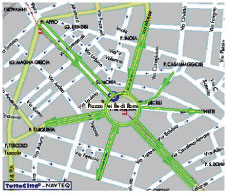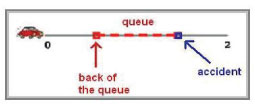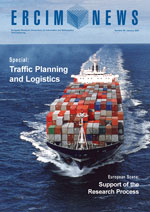by Gabriella Bretti, Roberto Natalini and Benedetto Piccoli
A new simulation algorithm based on fluid dynamics, which computes numerical solutions to traffic flow problems on road networks, has been developed. The algorithm reconstructs in real time the evolution of flow and density in road networks, and provides a better approximation with respect to classical models. A satisfactory reconstruction of the network load can be obtained with only a few measurements.
At the Istituto per le Applicazioni del Calcolo (IAC-CNR) in Rome, we have built a simulation tool reproducing the behaviour of traffic within a road network. The simulator prototype can describe the evolution of traffic over time, assigning as input data the initial and boundary conditions on the roads comprising the network, and taking interactions at junctions into consideration. One of the strengths of this tool is the low level of information needed to detect the load on the whole network. This is particularly important for urban traffic control, since actual traffic measurements rely on instruments placed at specific points in the network, typically measuring average fluxes per minute or similar.
There are many motivations for the study of traffic problems, including town planning, investment support, and reduction of congestion, car accidents and pollution. However, modelling traffic is a non-trivial task, and traffic jams in particular are difficult to reproduce.

Vehicular traffic can be treated by different models. We focus on macroscopic fluid-dynamic models, since they mimic phenomena such as the creation of shocks and their backward propagation along roads. Our reference mathematical model is based on conservation laws and represents an extension to road networks of the classical LWR model (Lighthill-Whitham-Richards) for a single road. A road network is a finite set of roads that are modelled by intervals and connected to each other by junctions. It is schematized as an oriented graph, where roads are modelled as arcs and junctions as nodes.
From a numerical point of view, the algorithm is based on approximation methods such as the Godunov scheme and kinetic schemes with suitable boundary conditions at junctions. It has been applied to sample cases and to a variety of real sections of urban networks such as bottlenecks, traffic circles and intersections (see Figures 2 and 3). We have investigated the numerical validity of the approximation algorithm. It has proven to be very fast, providing solutions on networks with a few thousands arcs in less than a second of CPU time on a PC, with ten points discretisation per arc.


We then tested the model's effectiveness on the whole road network of the city of Salerno. Using the simulation tool we constructed an algorithm that would trace the position of a car moving into a road network, and give an estimate of the time taken to traverse its route. We also ran tests to reproduce the effects of traffic jams on the trajectory of a single car (Figure 3). In this way, an optimal path can be calculated through a loaded network, taking into account the evolution of traffic over the whole network.
The fast numerical algorithms described above render the relative optimisation problem treatable. Furthermore, via the acquisition of experimental data measured by sensors located along roads (courtesy of Atac S.p.a. in Rome), we developed a procedure for calibrating traffic parameters on a segment of urban network in the centre of the city of Rome (Figure 4). This procedure is based on the comparison between measured data and the simulated solutions produced by the algorithm, and gives a percentage error of around 19% in the congested period. This is comparable with the average measurement errors of the sensors used and is therefore satisfactory.
The visualisation of simulations is provided by online animation. It is also possible to link the information to a GIS system as shown in Figures 1 and 2.
In the future, we intend to test the calibration procedure on whole networks, and to construct a real-time interface for the automatic representation and visualisation of density curves. Simulations on the network of the city of Salerno were performed in collaboration with the Department of Information Engineering and Applied Mathematics (DIIMA) at the University of Salerno.
Links:
http://www.iac.rm.cnr.it/~bretti/Fluid-dynamic.html
http://www.iac.rm.cnr.it/~natalini
http://www.iac.rm.cnr.it/~piccoli
Please contact:
Gabriella Bretti, IAC-CNR, Italy
Tel: +39 06 88470271
E-mail: g.bretti![]() iac.cnr.it
iac.cnr.it










